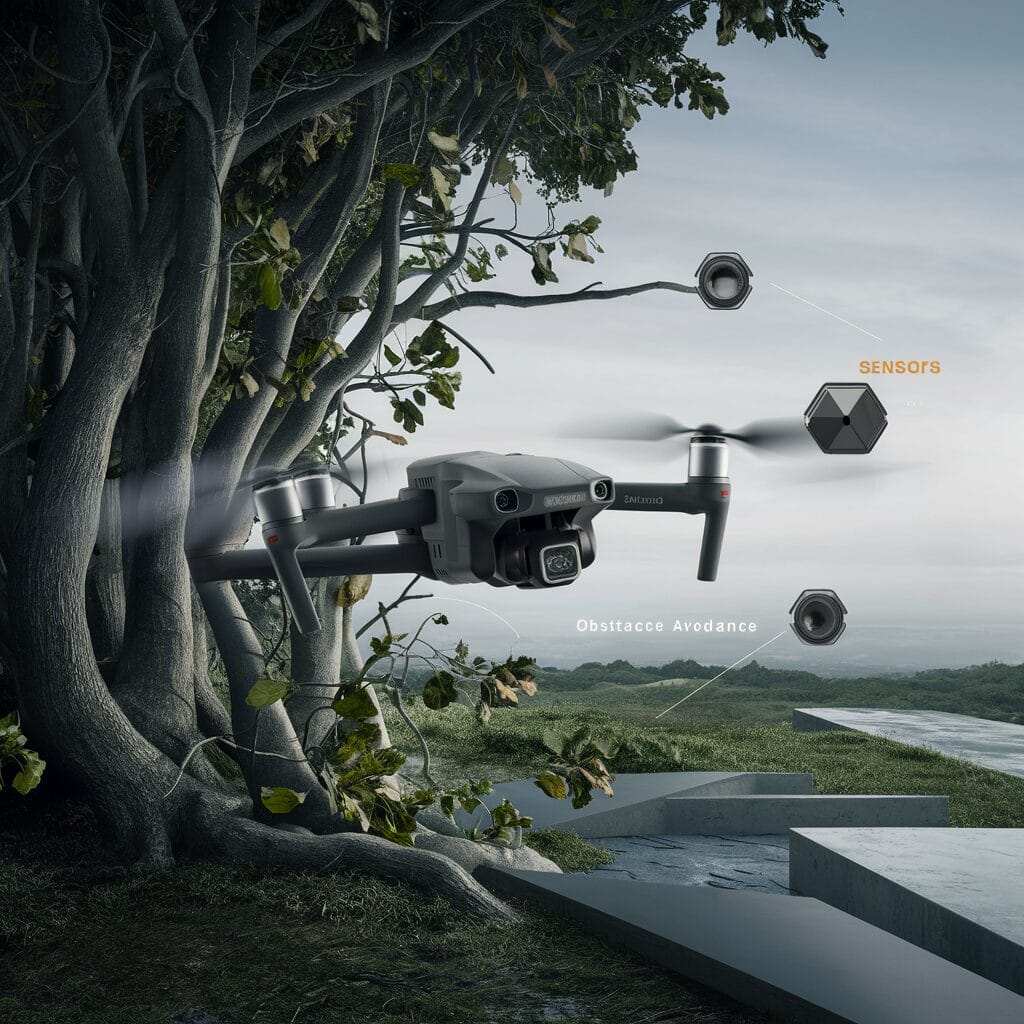
Anti-collision know-how in drones is revolutionizing the security and effectivity of unmanned aerial automobiles. By using superior sensors and algorithms, these programs can detect obstacles in actual time, enabling drones to navigate complicated environments with precision. This know-how performs an important position in stopping collisions and guaranteeing easy operations in numerous industries, from agriculture to filmmaking. With the rising recognition of drones for business and leisure use, the mixing of anti-collision know-how is turning into indispensable for secure and dependable flight experiences.
Key Takeaways
- Implementing anti-collision know-how in drones has considerably improved security over the historic journey of drone improvement.
- Key milestones in anti-collision tech, resembling impediment detection and avoidance programs, have performed an important position in enhancing drone security.
- Analyzing present anti-collision programs may help drone operators perceive their capabilities and limitations to make sure secure operations.
- The effectiveness and affect of anti-collision know-how on security underscore the significance of steady developments on this subject.
- Current developments in drone security, like AI-powered collision avoidance algorithms, exhibit the continuing evolution of security measures in drones.
- Future developments in collision prevention, together with enhanced sensor applied sciences and automatic response mechanisms, are set to revolutionize drone security practices.
Historic journey of drone security
Origins
Drones’ security measures have a long-standing historical past. Initially, security in drones was a secondary concern in comparison with performance. The evolution of drone security rules started when incidents highlighted the necessity for stringent measures. Over time, authorities launched pointers to make sure secure drone operations.
Rules
Rules governing drone security have progressed considerably over time. From primary operational pointers to complicated airspace restrictions, these rules goal to boost security requirements.
- Execs:
- Improved security protocols.
- Decreased threat of accidents.
- Cons:
- Compliance challenges for drone operators.
- Potential limitations on drone utilization.
Incidents
Historic incidents resembling collisions with plane or property harm performed an important position in elevating consciousness about drone security. These occasions underscored the significance of implementing sturdy security measures. The affect of those incidents led to heightened vigilance amongst regulators and trade gamers. Consequently, steady efforts are made to boost drone security protocols and stop future mishaps.
Key Milestones in Anti-collision Know-how in Drones
Breakthrough Applied sciences
Anti-collision know-how in drones has seen vital developments over time. Breakthrough applied sciences resembling LiDAR (Gentle Detection and Ranging) and RADAR (Radio Detection and Ranging) have revolutionized collision avoidance capabilities. LiDAR makes use of mild pulses to create detailed maps of environment, enabling drones to detect obstacles precisely.
RADAR, however, depends on radio waves to detect objects, providing a dependable answer for long-range impediment detection. These applied sciences have performed an important position in enhancing drone security by offering real-time knowledge on the drone’s environment, permitting it to navigate complicated environments with precision.
Improvement of Impediment Detection Programs
The event of impediment detection programs has been a key focus space in enhancing anti-collision know-how. Firms have been investing closely in creating superior sensors and cameras that allow drones to detect and keep away from obstacles autonomously. These programs use a mix of sensors, together with ultrasonic sensors, infrared sensors, and cameras, to supply complete protection of the drone’s environment.


By leveraging these subtle detection programs, drones can determine obstacles of their flight path and alter their trajectory accordingly to keep away from collisions. This functionality is especially essential in eventualities the place drones function in crowded or dynamic environments, guaranteeing secure and environment friendly operations.
Significance of Key Innovations
The importance of key innovations in anti-collision know-how can’t be overstated. Improvements resembling Sense and Keep away from (SAA) programs have performed a pivotal position in enabling drones to proactively sense potential collisions and take evasive actions. These programs depend on a mix of sensors and algorithms to research the setting repeatedly and make split-second selections to keep away from accidents.
Furthermore, developments in software program algorithms have enhanced the predictive capabilities of anti-collision programs, permitting drones to anticipate potential dangers earlier than they happen. By incorporating machine studying and synthetic intelligence strategies, these programs can study from previous experiences and enhance their collision avoidance methods over time.
Analyzing present anti-collision programs
Impediment Sensing
Impediment sensing is a crucial element of anti-collision know-how in drones. These programs use numerous sensors to detect obstacles within the drone’s flight path. Lidar, ultrasonic sensors, and infrared sensors are generally used for impediment detection.
Passive Sensors Passive sensors, resembling cameras and microphones, play an important position in enhancing the drone’s consciousness of its environment. These sensors seize visible and audio knowledge that may be processed to determine potential obstacles.
Processing
Environment friendly processing of sensor knowledge is crucial for fast decision-making in avoiding collisions. Superior algorithms analyze sensor inputs in actual time to calculate the drone’s place, pace, and trajectory relative to detected obstacles.
- Execs:
- Improved security throughout flights
- Enhanced situational consciousness for drone operators
- Cons:
- Restricted effectiveness in complicated environments
- Susceptibility to interference from exterior components
Kinds of Anti-Collision Applied sciences
A number of varieties of anti-collision applied sciences are utilized in drones right this moment, every with its distinctive method to stopping collisions:
- Geofencing: Establishes digital boundaries that prohibit the drone’s motion past specified areas.
- Computerized Dependent Surveillance-Broadcast (ADS-B): Allows drones to broadcast their positions to close by plane for collision avoidance.
- Radar Programs: Make the most of radio waves to detect objects and supply data on their distance and path.
Limitations and Challenges
Regardless of developments in anti-collision know-how, present programs nonetheless face vital limitations and challenges:
- Restricted Vary: Some programs might have restricted vary capabilities, impacting their potential to detect obstacles at longer distances.
- Environmental Components: Hostile climate circumstances or poor lighting can have an effect on the accuracy of sensor readings, resulting in potential collision dangers.
- Price: Implementing superior anti-collision programs might be expensive, particularly for business drone operators trying to scale their operations.
Effectiveness and affect on security
Security Enhancements
Anti-collision know-how performs a pivotal position in enhancing security within the drone trade. By routinely detecting obstacles and adjusting flight paths, these programs considerably scale back the chance of accidents. The flexibility to sense and keep away from collisions is essential in guaranteeing secure drone operations.
Quantifiable Influence
The implementation of anti-collision programs has led to a considerable lower in drone-related accidents. Research have proven that drones outfitted with collision prevention know-how are much less more likely to crash, thereby minimizing potential harm and accidents. Statistics reveal a big enchancment in security metrics for the reason that adoption of those superior programs.
- Execs:
- Decreased chance of accidents
- Enhanced safety for each drones and the encircling setting
- Improved public notion of drone know-how
- Cons:
- Preliminary price of integrating anti-collision know-how
- Upkeep necessities for these complicated programs
Actual-World Examples
Lately, quite a few incidents have highlighted the significance of anti-collision know-how in drones. For example, a drone surveying a development web site efficiently prevented a collision with a crane due to its superior sensors. This incident not solely prevented potential harm but additionally showcased how human intervention might be minimized with efficient security options.
One other notable case concerned a search-and-rescue operation the place a drone outfitted with collision prevention capabilities was capable of navigate by means of difficult terrain with none mishaps. The profitable completion of this mission underscored the crucial position that anti-collision programs play in guaranteeing operational success whereas sustaining excessive security requirements.
- DJI’s Phantom 4 Pro V2.0, recognized for its sturdy anti-collision options, has been broadly praised for its potential to detect obstacles precisely.
- Parrot Anafi FPV Drone incorporates cutting-edge collision avoidance know-how, making it perfect for rookies and professionals alike.
Current developments in drone security
AI Integration
AI integration in drone security programs has revolutionized the best way these units function. By leveraging AI algorithms, drones can now analyze knowledge in real-time to make split-second selections, enhancing their potential to keep away from collisions and guarantee secure flights.
Sensor Fusion Sensor fusion know-how performs an important position in enhancing drone security measures. By combining knowledge from numerous sensors resembling GPS, accelerometers, and gyroscopes, drones can create a complete image of their environment, enabling them to navigate complicated environments with precision.
Machine Studying Purposes
The incorporation of machine studying purposes in drone security options has considerably enhanced their capabilities. These programs can now study from previous experiences and adapt their conduct accordingly, making them extra environment friendly at avoiding obstacles and potential collisions.
- Improved collision avoidance: Drones outfitted with superior security options can detect obstacles of their flight path and autonomously maneuver round them.
- Actual-time decision-making: AI-powered programs allow drones to course of data quickly and make on the spot selections to stop accidents.
- Enhanced situational consciousness: Sensor fusion know-how offers drones with a 360-degree view of their environment, permitting for higher navigation in difficult circumstances.
Future Prospects
As know-how continues to evolve, the way forward for drone security appears promising. Improvements resembling improved battery life, enhanced impediment detection capabilities, and superior communication programs are on the horizon. These developments will additional solidify the place of drones as secure and dependable instruments for numerous purposes.
Future developments in collision prevention
Enhanced sensors
Drones are anticipated to combine superior sensors resembling LiDAR and radar, enabling them to detect obstacles extra precisely. These sensors will present real-time knowledge to the drone’s navigation system, enhancing its potential to keep away from collisions successfully.
Autonomous decision-making
Future collision applied sciences will deal with growing drones that may make autonomous selections primarily based on the info gathered by their sensors. This development will allow drones to navigate complicated environments with minimal human intervention, considerably enhancing security.
Integration of AI
The mixing of Synthetic Intelligence (AI) algorithms will play an important position in enhancing collision prevention in drones. AI-powered programs can analyze huge quantities of knowledge shortly, permitting drones to react swiftly to potential collision threats and navigate round obstacles effectively.
Elevated maneuverability
One key development in collision prevention is the event of drones with enhanced maneuverability capabilities. Drones outfitted with superior propulsion programs and management mechanisms will have the ability to carry out intricate maneuvers to keep away from obstacles successfully, lowering the chance of collisions.
Swarm know-how
An rising development in collision prevention is the usage of swarm know-how, the place a number of drones work collectively collaboratively to navigate by means of difficult environments. This method leverages collective intelligence and communication between drones to keep away from collisions and safely attain their locations.
Regulatory requirements
As collision applied sciences evolve, there shall be a rising emphasis on establishing regulatory requirements for drone security. These requirements will make sure that all drones are outfitted with efficient collision prevention programs and cling to strict security protocols, minimizing the chance of accidents.
- Execs:
- Enhanced security for drone operations.
- Improved effectivity in navigating complicated environments.
- Potential discount in accidents and collisions.
- Cons:
- Preliminary excessive prices related to integrating superior collision applied sciences.
- Challenges in guaranteeing compatibility with current drone fashions.
- Drones integrating superior sensors like LiDAR and radar.
- Autonomous decision-making talents enhancing security.
- Integration of AI algorithms for fast knowledge evaluation.
- Improvement of drones with enhanced maneuverability.
- Utilization of swarm know-how for collaborative navigation.
- Institution of regulatory requirements for drone security.
Improvements shaping drone security
Patents
Drone security has seen a big enhance by means of the introduction of modern applied sciences backed by quite a few patents. These patents cowl a variety of options, together with collision avoidance programs and superior sensors.
The mixing of patented collision avoidance programs permits drones to detect obstacles of their flight path and autonomously navigate round them, considerably lowering the chance of accidents. These programs depend on cutting-edge know-how resembling LiDAR and laptop imaginative and prescient algorithms.
Protection Business
The protection trade performs an important position in driving developments in drone security, leveraging its experience in growing state-of-the-art applied sciences for army purposes. Army-grade drones typically function sturdy collision prevention mechanisms that at the moment are being tailored for civilian use.
Army drones are outfitted with subtle applied sciences like radar-based detection programs and encrypted communication protocols, guaranteeing safe and secure operations even in high-risk environments. These developments are steadily making their means into business drone purposes, enhancing general security requirements.
Intersection with Different Technological Developments
The evolution of drone security intersects with different technological developments, making a synergistic impact that elevates general security measures. For example, the mixing of synthetic intelligence (AI) algorithms with drone navigation programs enhances real-time decision-making capabilities, enabling drones to reply swiftly to potential collision threats.
Furthermore, the incorporation of blockchain know-how offers an added layer of safety by guaranteeing knowledge integrity and stopping unauthorized entry to crucial flight data. This fusion of various technological parts underscores the multifaceted method to enhancing drone security requirements.
Rising Tendencies
- Elevated deal with real-time knowledge processing: Drones at the moment are outfitted with superior processors able to analyzing huge quantities of knowledge immediately, enabling fast decision-making throughout flight.
- Enhanced communication protocols: New communication requirements improve coordination between a number of drones in shared airspace, minimizing the chance of collisions.
- Integration of predictive analytics: Predictive analytics instruments assist anticipate potential dangers and proactively alter flight paths to keep away from accidents.
Predicting the following steps in drone tech
Future Integration
As drone know-how continues to evolve, the mixing of anti-collision programs is turning into more and more essential. These programs play an important position in enhancing drone security, particularly as drones are getting used throughout numerous industries. The longer term trajectory of drone tech factors in direction of seamless incorporation of subtle anti-collision options.
The mixing of anti-collision know-how with autonomous drones signifies a big leap ahead in drone improvement. By enabling drones to detect and keep away from obstacles autonomously, these programs are revolutionizing the best way drones navigate by means of completely different environments. This development not solely enhances operational effectivity but additionally minimizes the dangers related to collisions, notably when drones are deployed for duties resembling aerial pictures or surveying huge distances.
Regulatory Implications
With the fast development of drone know-how, regulatory our bodies are confronted with the problem of protecting tempo with these developments. The mixing of anti-collision programs raises vital questions concerning rules and pointers governing drone operations. As drones turn into extra autonomous and able to making split-second selections primarily based on enter from these programs, regulatory frameworks should adapt to make sure secure and accountable use of this know-how.
- Execs:
- Enhanced security for drone operations
- Elevated effectivity in numerous industries
- Decreased threat of collisions throughout flights
- Cons:
- Potential challenges in regulatory compliance
- Prices related to integrating superior anti-collision know-how
Hypothesis on Developments
Trying forward, developments in anti-collision know-how are anticipated to additional refine the capabilities of drones. From improved impediment detection algorithms to real-time decision-making processes, future developments will deal with enhancing the precision and reliability of those programs. This evolution is just not solely pushed by technological improvements but additionally by the rising demand for safer and extra environment friendly drone operations throughout various industries.
Closing Ideas
The journey of drone security has seen outstanding developments, with anti-collision know-how enjoying a pivotal position in enhancing operational security. From historic milestones to current improvements, the evolution of those programs has considerably impacted the effectiveness of collision prevention mechanisms. Trying forward, the way forward for drone security seems promising, with steady developments and cutting-edge applied sciences shaping the panorama.
Because the realm of anti-collision know-how in drones continues to evolve, staying knowledgeable concerning the newest developments and improvements is essential for trade professionals and fanatics alike. Embracing these developments not solely ensures safer drone operations but additionally fosters a tradition of innovation and progress throughout the drone group.
Ceaselessly Requested Questions
What’s the significance of anti-collision know-how in drones?
Anti-collision know-how in drones performs an important position in enhancing security by stopping mid-air collisions and accidents. It makes use of sensors and algorithms to detect obstacles, guaranteeing secure navigation.
How have anti-collision programs advanced over time?
Anti-collision programs have advanced from primary proximity sensors to stylish applied sciences like LiDAR and laptop imaginative and prescient. These developments allow drones to detect and keep away from obstacles extra successfully, enhancing general security.
Are present anti-collision programs efficient in enhancing drone security?
Sure, present anti-collision programs have proven vital effectiveness in lowering collision incidents amongst drones. By using a mix of sensors and software program algorithms, these programs assist improve situational consciousness and stop accidents.
What current developments have been made in drone security know-how?
Current developments in drone security know-how embody the mixing of synthetic intelligence for higher impediment recognition, improved battery life for longer flight occasions, and the event of geofencing to limit drone operations in sure areas.
What are some future developments anticipated in collision prevention for drones?
Future developments in collision prevention for drones embody the implementation of swarm intelligence for coordinated flight paths, enhanced communication protocols between drones, and the usage of predictive analytics to anticipate potential collision dangers.
Trending Merchandise











